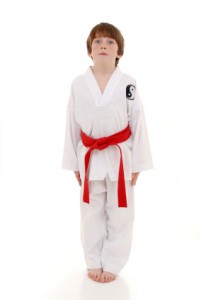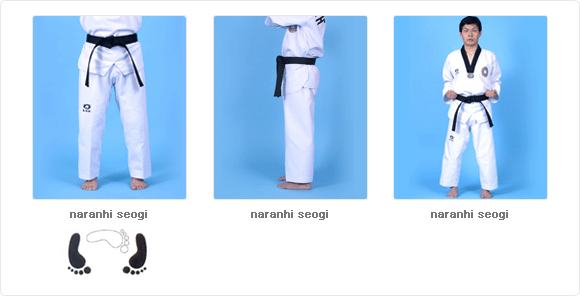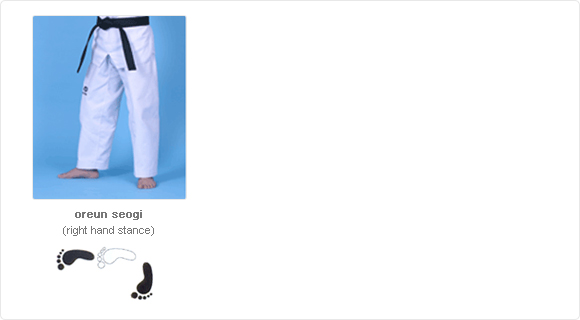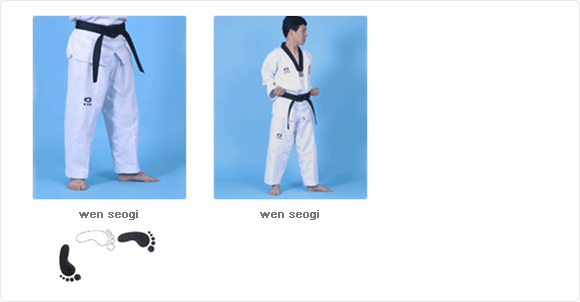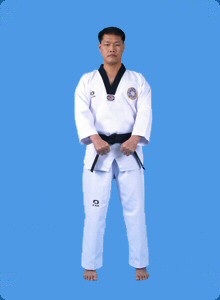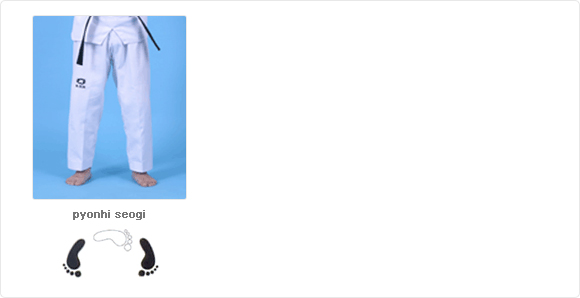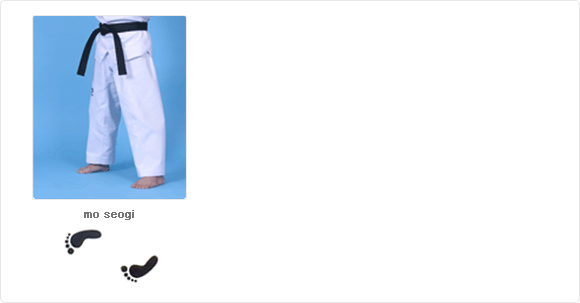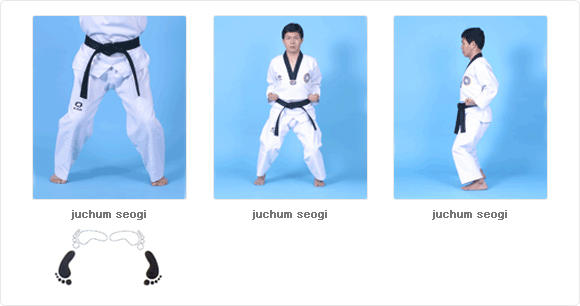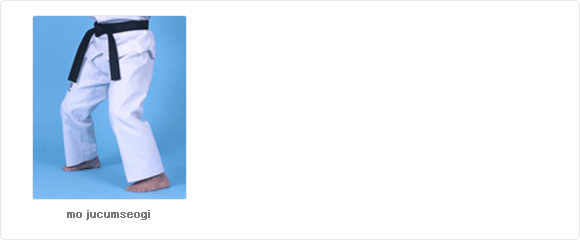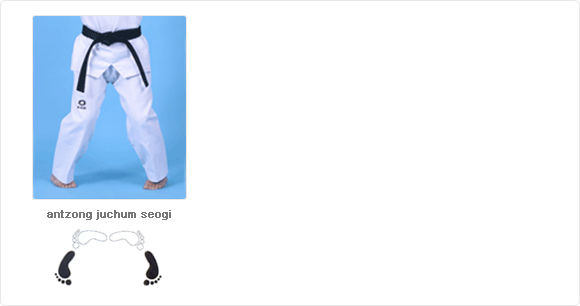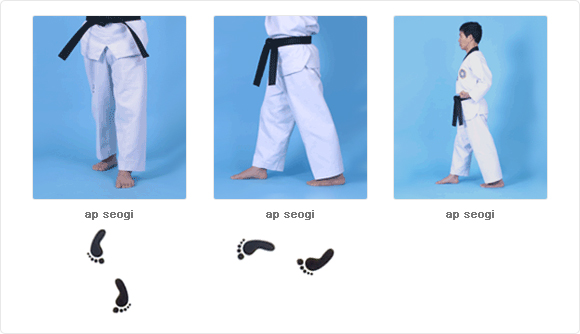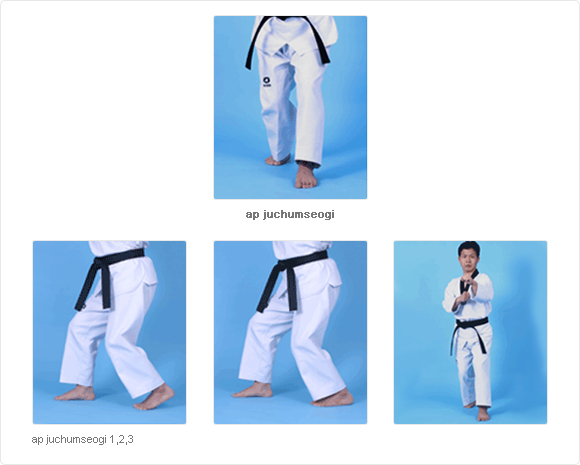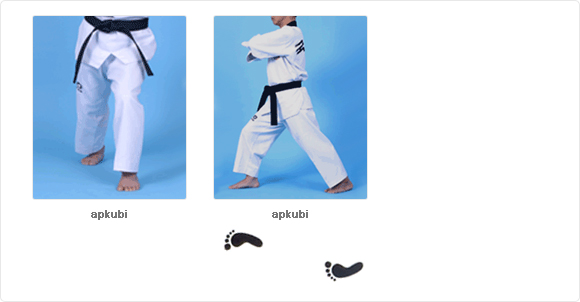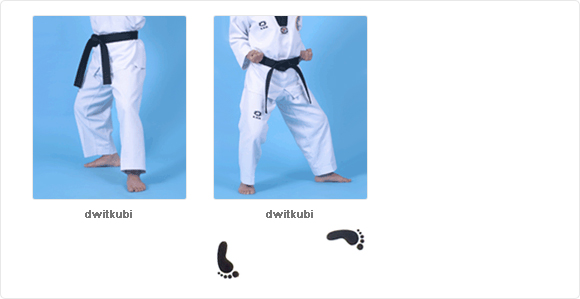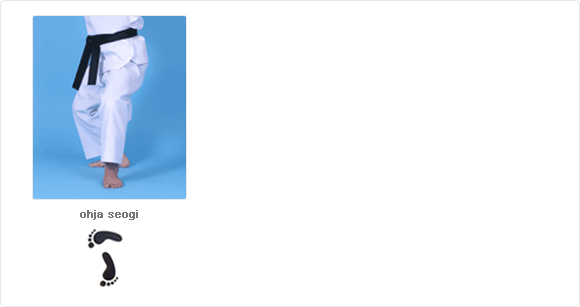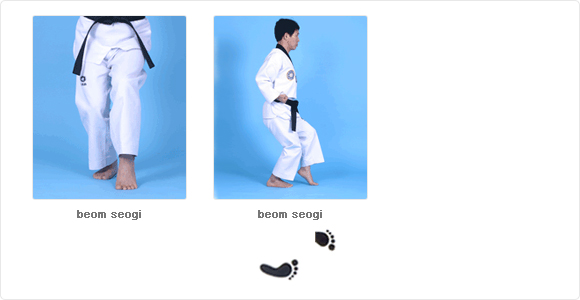The seogi (stance) means keeping any part of the body except the two feet not touching the ground or the floor, using the lower part of the body. The upper part of the body including the arms can make free motions, but the trunk should be kept always erect. The seogi techniques give great influences over the movement of the center of gravity and the center of weight, and there are various seogi techniques according to the positions and movements of two legs. Sometimes a ponderous posture makes the seogi technique ready for defense, and at times an unstabilized seogi makes the movement of the center speedy and exerts impulsive forces so that one may be ready to take next actions swiftly. The types of seogi are classified according to the position of feet, either widened apart side by side or fore and back and according to the way of keeping the knee, either stretched or inflected.
If the feet drawn close, the center of the body becomes unstable and the center of gravity goes higher, making the stance insecure, if the knees are stretched. Therefore, the wide open feet and the inflected knees make a balanced solid stance, which in turn lacks speedy movements of the center of the body as well as powerful impulsive force.
As mentioned above, the maintenance of balance is largely influenced by the width between two feet. Persons have different feet from one another; therefore, a balanced stance cannot be uniform among individuals. Usually, the unit of a stride or step is used to measure the breadth between the feet in a fore and back stance, while the unit of a sole length (e. g., one foot or two feet) can be also used for measurement in making a stance and the direction of eyes or the body will be the base line of an angle.
We will divide the stances into three categories, Neolpyo seogi (open stances), Moa seogi (close stances) and Teuksu Poom seogi (special poom stance).
Charyot seogi (attention stance)
This is the attention position used before and after class and it is the first stance learned in Taekwondo.
The feet are at 45 degrees. However, recent Kukkiwon changes now require feet to be touching and pointing forward, particularly in WTF recognized sporting events. Failure to do so results in point deduction during a competition.
Neolpyo seogi (open stances)
Naranhi seogi (parallel stance)
- 1. Pose:
-
- The breadth of two feet will be one foot wide, the inner sides (balnaldeung)of both feet paralleling with each other,
- Both knees are stretched, and
- Both legs will support your weight evenly, the center of balance coming between the legs.
- 2. Usage:
- This is a fundamental pattern of seogi to be used in the standstill posture or as a “junbi seogi”(ready stance).
Oreum seogi (right hand stance)
- 1. Pose:
- First, take the same pose as the naranhiseogi, and then move only the fore sole of right foot 90 degrees rightwards, pivoting on the heel.
- 2. Usage:
- This is used in mejumeok naeryochigi (hammer fist pounding hit) and deungjumeok bakkatchigi (hand back fist outward hit) techniques.
Wen seogi (left hand stance)
- 1. Pose:
- First, take the same pose as the naranhiseogi, and then move only the fore sole of right foot 90 degrees rightwards, pivoting on the heel.
- 2. Usage:
- This is used in mejumeok naeryochigi (hammer fist pounding hit) and deungjumeok bakkatchigi (hand back fist outward hit) techniques.
Junbi seogi (ready stance)
The upper body, waist, and knees are straight. Shoulders are relaxed, the chin is pulled in, eyes looking forward, and the feet are spread one shoulder width apart with the toes pointing straight forward. this stance is the starting point for all movements.
Pyonhi seagi (at ease stance)
- 1. Pose:
-
- Keep the breadth of two heels at one foot length, each fore sole opened outward by 60 degrees.
- The knees straightened, and
- Make the two legs support the body weight evenly, slightly leaning on the back sole side.
- 2. Usage:
- This stance is generally used for a ready stance.
Antzong seagi (inward stance)
- 1. Pose:
-
- Keep the breadth of two legs at two foot length,
- The two soles paralleling with each other,
- Lower the knees as high as they may spring up and down easily, and keep the shin from the foot to the knee erect vertically
- Concentrating the weight inwardly and tightening the lower abdomen.
- 2. Usage:
- This stance is more stable so that it can be used for various defensive and offensive techniques.
Mo seogi (oblique angle stance)
- 1. Pose:
- In a naranhiseogi (parallel stance), just put one foot (left or right) straight forward at a distance of one step.
The body weight should be supported by both legs evenly, the center or balance coming in between the legs.
- When the left foot is put forward, it is called a wen moseogi (left side moseogi), and the opposite way an oreun moseogi (righr side moseogi). When an oblique angle stance (moseogi) should return to a parallel stance(naranhi seogi), you have just to command “put your forward left (or right) foot back to a naranhiseogi!”
Joochoom Seogi (horse ridding stance)
The feet are one and a shoulder width apart. Both knees bent and perpendicular with the ankle. Push the chest slightly forward. Have both fists at waist level with wrists facing upward. The point of balance is between the feet.
Nachuwo seogi (lowered riding stance)
- 1. Pose:
- Proceed with the same way as the juchumseogi except that the legs should be open wider, keeping the body lower.
- 2. Usage:
- The low center of weight makes the body the most balanced, but with less impulsive force; it needs more strength in making every action : therefore, this is generally used for developing the power.
Mo Jochum seogi (oblique angle riding stance)
- 1. Pose:
- In a juchumseogi, the right or left foot only will be put straight forward at a distance of one step.
- 2. Usage:
Antzong Juchum seogi (inward riding stance)
- 1. Pose:
- Also in a riding stance (juchum seogi), only the fore soles of both feet will look inward pulling the back soles outward.
- 2. Usage:
- The same as juchum seogi’s usage, using the strengthening the power of the lower muscle.
Ap seogi (forward stance)
- 1. Pose:
-
- Just like the stance when one stops walking with a forward step. the distance of the two feet is one step long,
- The inner sides of two feet must be on a straight line,
- The two knees should be kept straightened, the weight being supported by both legs evenly.
- It is permitted to keep the hind foot slightly turned from the straight line within the angle of 30 degrees in order to allow a natural pose.
- 2. Usage:
- Generally for the offensive purpose, but sometimes for the defensive purpose, too.
Ap Juchum seogi (forward riding stance)
- 1. Pose:
- The same as the apseogi except that the knees are lowered like the juchumseogi. In taking this pose, the back sole of the fore foot is likely to be pushed outward, but the angle of turning should be kept within 30 degrees. The weight should be supported by both feet, raising the back soles slightly so that impulsive force can be exerted.
- 2. Usage:
- This is used in the posture of aiming at the target during a kyorugi and can make very impulsive motions.
Apkubi (forward inflection stance)
- 1. Pose:
-
- The vertical distance between two feet is one and a half step. And the parallel distance between two feet’s tiptoes is one foot.
- The tiptoes of front foot place forward.
- Tower the knee in order to match your knee and tiptoes when you look down in a upright standing position.
- Keep the back sole turned inward within the angle of 30 degrees and stretch the knee of hind leg and put the balance of your weight forward by two-thirds.
- Stand upright and twist forward your body at an angle of 30 degrees.
- 2. Usage:
This stance makes it easy to push forward, thereby enabling one to perform attack techniques.
Dwitkubi (backward inflection stance)
1. Pose:
- (in case of right hand dwitkubi)
- ⓐfrom the moa seogi (close stance), the fore sole or right foot is opened at an angle of 90 degrees, pivoting on the back sole,
- ⓑthen the left foot is put one step forward from the heel of the right foot, making an angle of 90 degrees and the body is lowered by the inflection of two knees.
- ⓒThe inflection of the right foot knee will keep an angle of 60 to 70 degrees between the ground and the shin and the inflection of the left foot knee an angle of 100 to 110 degrees between the ground and the left shin. The two knees inwardly like the ap juchumseogi (forward riding stance),
- ⓓand the center of weight as well as the center of balance will be laid on the right foot by two thirds.
2. Usage: with the weight learning backward, this stance makes one move backward easily, thus applying itself to defense techniques.
- As explained in the mo seogi, the stance is classified by oreun seogi (right hand stance) and wen seogi (left hand stance) according to the forwarded leg, but this stance classifies itself by the backward leg. So, there can be the oreun dwitkubi (right hand backward inflection stance) and the wen dwitkubi (left hand backward inflection stance).
Ohja seogi (inverted “T” shape stance)
- 1. Pose:
- His stance is almost the same as the dwitkubi, except that the forwarded foot makes a right square with the back foot. In other words, the extended line of the forwarded foot’s sole crossed the center of balnaldeung (foot balde’s back) of the back foot, thus the two soles forming an inverted “T” letter shape. This forward leg with an inside position is ready to defend one’s groin from his opponent’s attack and also to deliver momdollyo chagi techniques.
- 2. Usage:
- This is a defensive posture as well as a surprise attack stance.
Beom seogi (tiger stance)
- 1. Pose:
- In case of the oreun (right hand) beom seogi),
- From the position of moaseogi, the left foot is put one foot forward. And the right (hind) foot is opening the fore sole 30 degrees on the basis of the back sole.
- The weight is entirely supported by the right(hind) foot behind. Place the knee and tiptoes match when you look down.
- The left foot in front will keep the ankle stretched so that its tiptoes or the fore sole alone may lightly touch the ground, and the knee will bend down as much as it is required.
- Concentrate the force on the lower abdomen, the weight is supported 100% by the right(hind) foot.
- 2. Usage:
- This stance is mainly used in offense, applying counter-kicks with the front foot, as it is not supporting the weight, and at times returning counterattack, or blocking the opponent’s attack of the shin to counterattack with hands.

